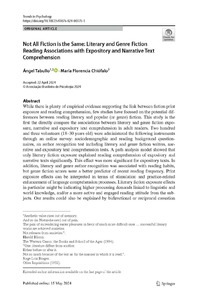Por favor, use este identificador para citar o enlazar este ítem:
https://repositorio.uca.edu.ar/handle/123456789/18358| Campo DC | Valor | Lengua/Idioma |
|---|---|---|
| dc.contributor.author | Tabullo, Angel | es |
| dc.contributor.author | Chiófalo, María Florencia | es |
| dc.date.accessioned | 2024-07-01T21:49:31Z | - |
| dc.date.available | 2024-07-01T21:49:31Z | - |
| dc.date.issued | 2024 | - |
| dc.identifier.citation | Tabullo, A., Chiófalo, M. F. Not all fiction is the same: literary and genre fiction reading associations with expository and narrative text comprehension [en línea]. Trends in Psychology. 2024. doi: 10.1007/s43076-024-00376-1. Disponible en: https://repositorio.uca.edu.ar/handle/123456789/18358 | es |
| dc.identifier.issn | 2358-1883 (online) | - |
| dc.identifier.uri | https://repositorio.uca.edu.ar/handle/123456789/18358 | - |
| dc.description.abstract | Abstract: While there is plenty of empirical evidence supporting the link between fiction print exposure and reading comprehension, few studies have focused on the potential differences between reading literary and popular (or genre) fiction. This study is the first the directly compare the associations between literary and genre fiction exposure, narrative and expository text comprehension in adult readers. Two hundred and three volunteers (18–30 years old) were administered the following instruments through an online survey: sociodemographic and reading background questionnaires, an author recognition test including literary and genre fiction writers, narrative and expository text comprehension tests. A path analysis model showed that only literary fiction exposure explained reading comprehension of expository and narrative texts significantly. This effect was more significant for expository texts. In addition, literary and genre author recognition was associated with reading habits, but genre fiction scores were a better predictor of recent reading frequency. Print exposure effects can be interpreted in terms of stimulation and practice-related enhancement of language comprehension processes. Literary fiction exposure effects in particular might be indicating higher processing demands linked to linguistic and world knowledge, and/or a more active and engaged reading attitude from the subjects. Our results could also be explained by bidirectional or reciprocal causation between print exposure and comprehension. These findings highlight the importance of considering text features (particularly, literary quality) while examining the link between print exposure and reading comprehension. | es |
| dc.format | application/pdf | es |
| dc.language.iso | eng | es |
| dc.publisher | Sociedade Brasileira de Psicologia | es |
| dc.rights | Acceso restringido | * |
| dc.rights.uri | http://creativecommons.org/licenses/by-nc-sa/4.0/ | * |
| dc.source | Trends in Psychology. 2024. | es |
| dc.subject | COMPRENSION LECTORA | es |
| dc.subject | FICCION | es |
| dc.subject | NARRATIVA | es |
| dc.subject | TEXTO EXPOSITIVO | es |
| dc.title | Not all fiction is the same: literary and genre fiction reading associations with expository and narrative text comprehension | es |
| dc.type | Artículo | es |
| dc.identifier.doi | 10.1007/s43076-024-00376-1 | - |
| uca.disciplina | PSICOPEDAGOGIA | es |
| uca.issnrd | 0 | es |
| uca.affiliation | Fil: Tabullo, Angel. Consejo Nacional de Investigaciones Científicas y Técnicas. Instituto de Ciencias Humanas, Sociales y Ambientales; Argentina | es |
| uca.affiliation | Fil: Tabullo, Angel. Pontificia Universidad Católica Argentina. Facultad de Humanidades y Ciencias Económicas; Argentina | es |
| uca.affiliation | Fil: Chiófalo, María Florencia. Pontificia Universidad Católica Argentina. Facultad de Humanidades y Ciencias Económicas; Argentina | es |
| uca.version | publishedVersion | es |
| item.fulltext | With Fulltext | - |
| item.grantfulltext | mixedopen | - |
| item.languageiso639-1 | en | - |
| Aparece en las colecciones: | Artículos | |
Ficheros en este ítem:
| Fichero | Descripción | Tamaño | Formato | Login |
|---|---|---|---|---|
| not-all-fiction.pdf | 909,46 kB | Adobe PDF | SOLICITAR ACCESO | |
| not_all_fiction.jpeg | 351,63 kB | JPEG |  Visualizar/Abrir |
Este ítem está sujeto a una Licencia Creative Commons

